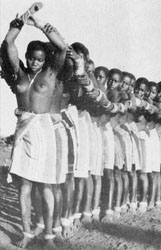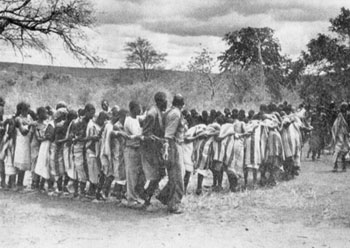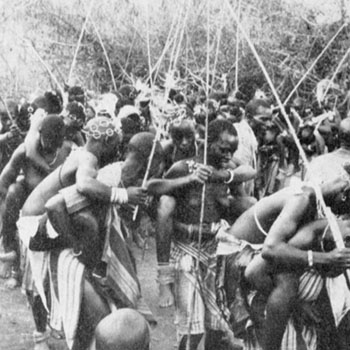| THE DANCE
Domba must be danced on the first night of each school. This first performance is really a first rehearsal, and thus it is usually chaotic. The drums are played by married women, who also show the novices how to dance. Although they have performed it before and know the parts, and although the novices have seen and heard domba many times, they have not played together as a team. The dance is held at the home of the ruler of the district: thus the girls of the previous domba have almost certainly been married and taken to their husbands' homes; and few, if any, of the married women have played or danced together, because they have been brought as wives from several different areas. Even when several of the married women at a chief's village had graduated together at a previous domba, I found the first performance disorganised. The first novices to join are members of the chief's family, because they are expected to set a good example (line 30: I tshi luma i ranga wayo - if it bites [cf. a dog], it begins with its own kith and kin), and commoners do not wish to be thought too arrogant or forward (lines 233: Vhamusanda ndi philiphili - the chief is [like] a river bank; and 234: A
During the evening dance of the second or third day, they may begin to learn one of the recreational songs of domba, and also Tshilalelo. This 'song of dismissal', in which the girls 'ask for their supper' (ri yo humbela tshilalelo), has the same step and drum rhythm as domba, but a different melody. Khumbela-tshilalelo is also a name for Venus as the evening star. After about five days, when the girls are singing and playing better, the midday rehearsal is omitted, so that the novices may be free to help in the homes and fields of their families. Thereafter, domba is danced in the middle of the day only on Saturdays and Sundays. This is said to be a change that was made to suit the pattern of the 'modern' week and the absence of working men and youths. Each novice must everyday bring wood for the domba fire. After two or three weeks, the novices are allowed to come to domba wearing their salempore cloaks, but they must remove these when they dance. Girls who are menstruating usually wear salempores round their waists. Girls are also allowed to wear necklaces, leg and arm bangles, and various additions to the pubic apron. These are muteputepu, a 'tail' of cloth covered with buttons; and mukethengwa, four or five circlets of loosely joined brass beads, or thuthu, 'woven' strings of metal clasps, either of which are worn round the hip.
Youths at domba are called madunana (lit. young men), and girls, mbebo (lit. progeny, issue) (lines 3 and 47). The dance movement is called uhaka deu (lines 71-73): the dancers stand closely together in file and each holds the arms of the novice in front. It is considered most difficult to dance in front, because of the 'pressure' of the people behind; and so new recruits are put there, so that they will quickly learn to dance.
The dance movement is simple in itself, but requires careful co-ordination with the drum rhythm: the girls' song follows the beat of the alto drums, but their feet must follow the tenor drum. At first they step left-right-left-right etc. to every beat of the tenor drum (the large L and R of the Dance Steps). When they are able to do this correctly, they double the pace, but step left-right-left-right-left-right etc. They may do this regularly to the alternate beats of the tenor and alto drums, as in the transcription, i.e. at intervals of a dotted crotchet; or they may follow an uneven rhythm of crotchet-minim-crotchet minim etc. (corresponding to steps left-right-left-right etc.). In this case they are using the same rhythm as the bass drum, but at twice the speed and following the different main beat of the tenor drum.
If married women or graduates (midabe) of another domba are present, they may wish to dance with the novices. They express their different social status by moving independently of the deu, and outside it. Their movement is called -dabela. Following the beat of the tenor drum, they step four paces to every repeat of the total drum pattern. They step forwards casually, left-right-left-right, completing the movement with a forward swing of the left leg. Swinging back the left leg and placing it on the ground, they move back, left-right-left-right, and complete the movement with a backward swing of the left leg (see Dance Steps). They follow this forward/backward sequence in such a way that each move forward begins a little in front of the starting point of the previous movement. When they perform debela, women usually dance in pairs or groups of four, and both clockwise and anti-clockwise, so that if there are many of them, they continually pass 'through' each other. On the last day of domba, married women and former graduates dance deu, and the novices are suppose to perform dabela for the first time. When the novices have been dressed in their graduation uniform and carried to the dancing ground by their 'mothers', they are danced round on their 'mother's' backs, before taking part in the final dance of the school.
|
|||||||||||||||||||

 Domba at Luwando, 1956. A characteristic arm movement by the leader of the domba chain. Normally, salempores are worn round the waist only by those who are having their menses: but on this occasion they had heard that the author was staying at a mission station, and might therefore be offended by their customary nudity.
Domba at Luwando, 1956. A characteristic arm movement by the leader of the domba chain. Normally, salempores are worn round the waist only by those who are having their menses: but on this occasion they had heard that the author was staying at a mission station, and might therefore be offended by their customary nudity.
